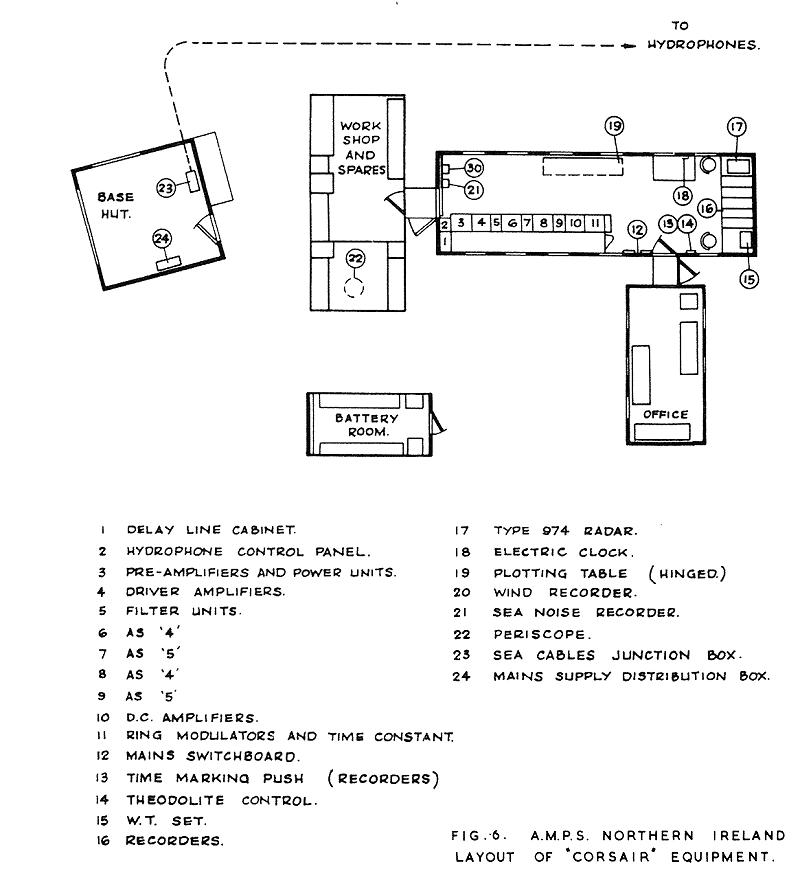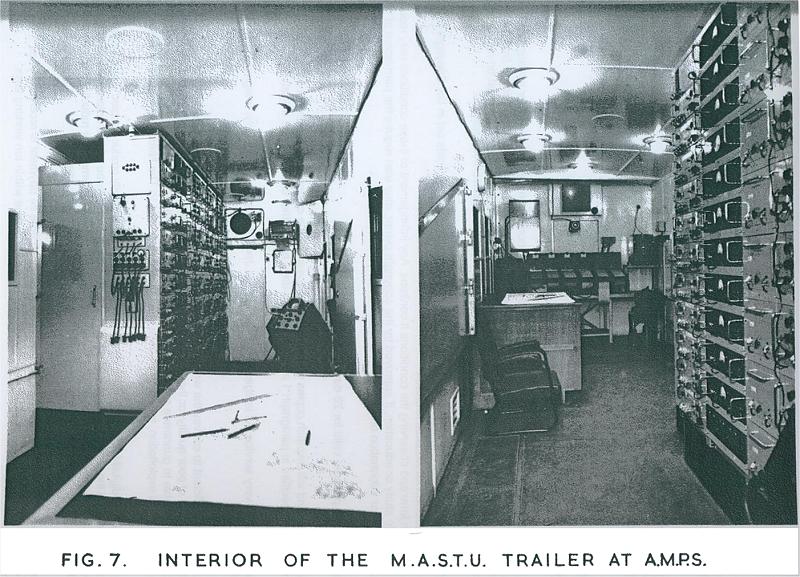 CORSAIR:
Admiralty Marine Physical Station, Portballintrae N.I.
CORSAIR:
Admiralty Marine Physical Station, Portballintrae N.I.
 CORSAIR:
Admiralty Marine Physical Station, Portballintrae N.I.
CORSAIR:
Admiralty Marine Physical Station, Portballintrae N.I.
SHORE EQUIPMENT AND OPERATIONAL TECHNIQUES
As stated on the previous page, the Admiralty Marine Physical Station was constructed at Portballintrae to investigate operational techniques using an Admiralty Research Laboratory (ARL) -designed CORSAIR submarine detection system. The hydrophone arrangement was such as to provide information on the course and speed of contacts on the assumption that these remain more or less constant – see note 1, below. It consisted of two arrays laid about 3 miles off shore in 50 fathoms and about 1000 yards apart with their axes pointing northwards towards Islay, about 20 miles away. The most westerly of these arrays (B) was made up of two hydrophones separated by 30 yards; the other array (A) consisted of six hydrophones, the idea being to employ a certain amount of directivity, but these were found to be lying irregularly on the sea bed and only a pair 30yds apart was used in this array also. All hydrophones included a head amplifier.
The general layout of the shore equipment is shown in Fig. 5, below. The Type 275 radar, at the eastern end of the site, was a new addition for directing aircraft over underwater targets on information supplied from the CORSAIR unit. The CORSAIR equipment, (mainly) housed in three R.N. trailers, compactly arranged at the western end of the site, was in operation for experimental purposes from September 1953.

A more detailed sketch of the latter is shown in Fig. 6, below. Cables from the hydrophones were led into a junction box in the base hut and thence to pre-amplifiers and a control panel for the head amplifiers in the M.A/S.T.U. (see note 2, below) trailer. The signals from the pre-amplifiers were amplified further and could be routed through Octave filters covering bands between 50 and 3200 Hz. The amplifiers were paired; each pair fed into one of twelve ring modulators and the output from each of these fed into a variable time-constant smoothing circuit forming part of the feed-back loop of an (A.E.R.E. vibrating reed) D.C. amplifier. The output of the D.C. amplifier, which varied according to the level of correlation between the pair of hydrophone signals, was displayed on a direct-writing pen recorder; four 3-pen recorders were employed for the twelve channels. Time markings could be recorded on all traces simultaneously by press button.

A system of delay lines of the low pass filter type was included such that sections could be inserted between the pre-amplifiers and main amplifiers. A total delay of 20 milliseconds was available in 0.23 milliseconds increments. With a hydrophone separation of 30 yds, 1 millisecond of delay corresponds to about 3 degrees change in the direction of an array axis.

The Admiralty Research Laboratory installation at AMPS Portballintrae included ancillary equipment: a type 974 radar (see note 3) with chart comparison unit, various communications equipment, a periscope which allows the whole sea horizon to be viewed from inside one of the trailers, a large plotting board, and wind, swell and sea noise recorders.
Theory of Operation
tbc
Notes
1. The position of the hydrophones, the axes of the arrays and change of direction introduced by the delay units, all needed to be accurately known as the fundamental requirement for the CORSAIR system was to provide sufficiently high accuracy (time-related) target positions to allow course and speed to be calculated with some certainty; certainly accurate enough to be of use to other units tasked to prosecute the detected, underwater target.
2. No explanation of “M.A/S.T.U.” is given in the ARL Annual Report covering 1950-4 – the period when ARL was involved at AMPS. An informed guess is that it stands for Mobile Anti-Submarine Tracking Unit; A/S was in common usage as a short-form for Anti-Submarine.
3. Two radar installations on the site seem excessive and beg the question whether the 974 radar pre-dates the site’s use by the Admiralty Research Laboratory. There exists anecdotal evidence that a WWII Controlled Minefield with a Magnetic Loop Submarine Detection adjunct was operated from this site, prior to its final use by the Admiralty Research Laboratory's CORSAIR experiment over the period 1953 to May 1955 when the site was cleared.
Page under construction